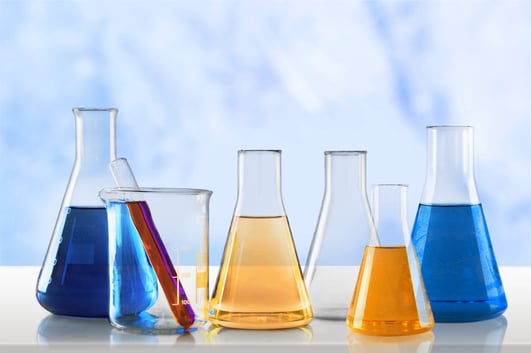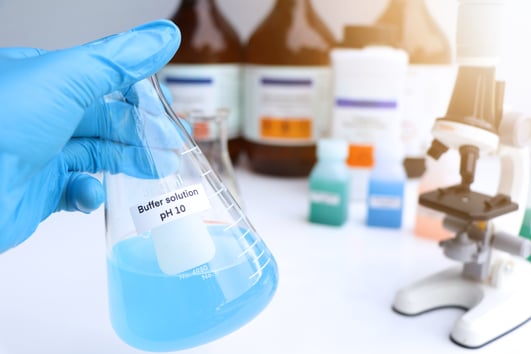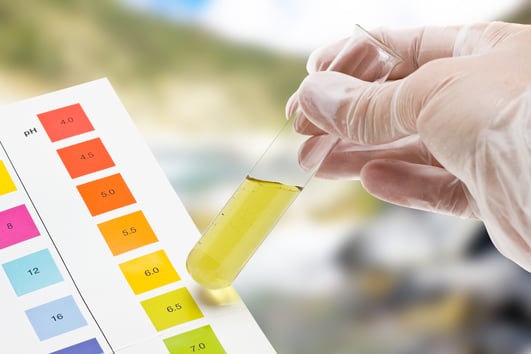When cleaners get together and discuss technical topics, the subject of pH is likely to come up. Even more so, this has been true of dialogue between industry instructors, product formulators, and chemists. What is behind the flap?
Realizing that IICRC carpet cleaning classes are not college chemistry classes, instructors and others on the committees working on the content of the classes wanted to keep things simple. Efforts to simplify meant that some information had to be left out. Many instructors had extensive personal experience in carpet cleaning but limited training in chemistry. The statement that wool should be cleaned using products with a pH between 4.5 and 8.0 appears to have been incorrectly attributed to Wools of New Zealand. These factors and others resulted in students getting a somewhat distorted view of pH as it related to cleaning
Why You Should Understand pH

Reading an article in Cleanfax, and chatting with other cleaners at Cleanfax.com will not qualify you to formulate your own cleaning chemicals. Developing well-formulated cleaning agents including spot and stain removers is accomplished by trained experts. They are able to test their creations in laboratories to see how well they perform. So, please don’t view this as guidance on how to mix your own chemicals at home.
It is important to understand how and why one cleaning agent works differently than another. This will allow you to select the best product for any particular situation. Understanding pH will help you in your spot-cleaning efforts. Your knowledge will demonstrate your professionalism and aid in gaining your customer’s confidence.
Most cleaning is accomplished by physical changes not chemical reactions. Chemical reactions can remove color and damage fibers. Knowing how chemicals will react will help us avoid damage to the carpets, rugs and upholstery we clean. But pH is only part of the reason chemical reactions occur. Reactivity, pH, buffering and total alkalinity all play a role.
What’s the Difference between a Physical Change and a Chemical Reaction?
A chemical reaction means molecules of one kind are changing to molecules of something different. For example, a chemical reaction occurs when we use an acid rust remover. This does not physically remove the rust. Rather it changes the rust to a new substance that is colorless. Chemical reactions also happen when using some stain removers that add or remove oxygen from the molecules that provide the color in a stain. This is called oxidation or reduction. More accurately it is both oxidation and reduction at the same time. If oxygen is added to one molecule it must have been removed from another molecule. A chemist would call it a redox reaction.
Most cleaning involves physical changes, not chemical changes. An example of a physical change is dissolving salt into water. This is called a solution. Water is the solvent. Salt is the solute. Even though the salt and water are combined, it is still water and salt. When the water evaporates, the salt will be left behind. It did not change into something different. They remained water and salt. Water and oil soluble soils are often removed by dissolving them and extracting the solution.
Another type of physical combination is a mixture. A mixture occurs when two chemicals are combined but they do not react with each other. An example would be combining salt and sugar. There is no chemical reaction to form a new compound. Neither is dissolved by the other. The salt and the sugar are mixed together but remain distinct from each other.
Water and oil do not usually mix. Cleaning agents may break up oil into tiny droplets suspended in the water. This is called an emulsion. An emulsion is one type of a mixture. Oils and grease may be emulsified. The mixture of water and oil is then extracted.
Some elements react more readily than others. Our atmosphere is another example of a mixture. It is composed largely of Nitrogen along with oxygen, carbon dioxide and small amounts of other gases.
The Nitrogen seldom reacts with whatever is around it. Oxygen reacts with many things around us. Oxygen reacts with iron to form rust. Whenever a flame is burning something is reacting with Oxygen. Oxygen reacts with oils resulting in a difficult-to-remove discoloration. These reactions have nothing to do with pH.
The key point is that the pH of the chemicals involved is only one of the factors that determine what if any, chemical reaction takes place.
pH – What is It and What Do the Numbers Mean? NOTE: This section should be pulled out as a sidebar.

pH tells us the number of ions or electrically charged particles present in a liquid. The number of ions present (pH) is another of the factors that determine if a chemical reaction will take place. You don’t need to know a lot about pH for to use it to aid your cleaning. If you want more detail read the box below. If you prefer to ‘keep it simple’ skip past.
pH is an abbreviation of a French term. The English equivalent is “power of Hydrogen.” Here is the official definition of pH. pH is the negative logarithm (in base 10) of the number of Hydrogen ions in one liter of a solution.
It is not necessary to fully understand that official definition of pH to see how pH effects your cleaning. However, some of you are asking yourselves. “What does that mean?”
Ions are molecules that have either gained or lost an electron. So they are no longer electrically balanced. They will either have a negative charge (extra electron) or a positive charge (missing an electron).
Water molecules (H2O) are composed of two atoms of Hydrogen (H) and one atom of Oxygen (O). A very few of these molecules will separate into an H+ ion and OH- ion. In pure water there will be an equal number of each. There will be .0000001 H+ ions (10-7) molecules in each liter of water. The pH of pure water is 7, the negative of the power of 10 from counting those ions
When a substance is dissolved in water the number of Hydrogen ions may increase or decrease. If the result is fewer H+ ions the solution is alkaline. If there are more H+ ions the solution is an acid
The pH scale ranges from 0 to 14. Numbers below 7 are acid. Numbers greater than 7 are alkaline. The further from 7 the stronger the acid or alkaline. Each whole number difference represents a tenfold change.
Pure water is neutral — pH 7. However, almost anything dissolved in the water, in any amount, will affect the pH. Freshly distilled water rapidly absorbs carbon dioxide from the air and reaches a pH of 5.5 in a very short time. Other materials dissolved in the water may have an even more marked effect. Depending on its chemical characteristics, it can either raise or lower the pH value. Thus the pH of any solution depends on the type and amount of materials dissolved in the water.
Each number on the pH scale actually represents a 10 fold difference. Thus, pH 4 is ten times as acidic as a pH 5 solution. A pH 3 solution, in turn has ten times the strength of the pH 4 solution - and 100 times the acidity of the pH 5 solution. This pH scale of 0 to 14 is derived from the chemical properties of water and this pH scale cannot be used without water.
To help visualize how quickly the strength changes, think of pH 7 being the thickness of a sheet of paper. A pH of 10 is 7”, about as tall as a water glass. Moving to an 11 is the height of an average man, about 5’10”! A pH of 14 would be well over a mile high.
Remember, the pH numbers represent only a part of the picture. Other factors influence if there will be a chemical reaction and how strong that reaction will be. The pH scale does not show the reactivity or concentration of a chemical. The pH chart does not tell us if a chemical will maintain that pH or easily change in the presence of other chemicals.
Total Alkalinity
Total alkalinity indicates how well a chemical compound will maintain its pH. To visualize this concept think about soldiers marching in formation. Let pH indicate how many columns of soldiers in the formation. The further from 7, the greater the number of columns. Alkalinity indicates how deep the columns are.
If something tries to change the pH, how much strength is in reserve to maintain the ranks? Some materials tend to stabilize a solution so that it maintains a specific pH. A buffered solution tends to resist a change in pH when acids or alkali are added. A cleaning solution that can maintain its pH in the presence of soil and other chemicals is said to be buffered.
Ingredients in a cleaning product that increase the total alkalinity are called builders. Builders may be added to buffer a product. Builders also help to counteract the effects of hard water.
The natural pH of most carpet fibers is near neutral (7). For wool, the natural pH will be between 5.5 and 7. For the life of the fiber and to keep from attracting soils, we should leave the fibers as close to possible to their natural pH when we have finished cleaning.
Now that we know what pH is, let’s see how to apply this information to our cleaning.
Using pH In Our Cleaning
Most soils are acidic, averaging between 4 and 5. Soils will be easier to remove when they are neutral. When alkaline mixes with fats, oils and grease they form soap. Our forefathers would mix beef or pork tallow (fat) with a lye (sodium hydroxide or potassium hydroxide), a strong alkaline to form lye soap. So the most effective cleaning agents are alkaline.
The American Association of Textile Chemists and Colorist recommends a pH no greater than 10.0 for use on nylon and most synthetic fibers. Cleaning agents with higher pH can be used on olefin.
We try to leave the fibers, after cleaning, as close to a pH of 7 as possible. Treating the fibers with an acid rinse agent or a spray application of an acid accomplishes this. Because Mrs. Home-owner may not like the idea of acid being sprayed on her carpet, our industry has adopted the German term for acid, source, to describe these products.
Testing pH

The pH factor can also be important in removing stains. pH can be checked with paper strips (Phydrion paper) or an electronic meter.
To use pH paper, moisten the stain slightly with water and press a piece of Phydrion paper to the carpet and check the color of the paper on the pH chart provided. Some of the color may transfer to the fibers. A safer way is to scoop up some of the moisture from the stain and apply this to the pH strip. Soils and oil from the fingers can affect the reading, so don’t touch the part of the paper where the reading will be made. Compare the color of the paper to the color guide on the Phydrion container to determine the pH solution of the spot.
There are some great meters available to check pH. The cost is under $100. To check the pH with a meter - Wet the stain. Then touch the tip of the meter onto the stain and press the button to take a reading. The pH will be shown on the display.
Meters can be calibrated to give answers accurate to two decimal places. Usually, this degree of accuracy is not required. Generally, a cleaner does not need to know the exact pH, only a general range. For example 0-3 would be a strong acid. 3-6 is mildly acidic. This is the range for many food spills. 6-8 is neutral on so forth. The chart on page X will help you interpret pH readings as they apply to cleaning and spot removal.
|
|
pH READING |
LIKELY SOURCE |
ACTION TO TAKE |
|
Spot(s) |
Less than 3.0 with color loss |
Strong acid such as toilet bowl cleaner, battery acid, and some rust removers. Hydrochloric acid, sulfuric acid |
Neutralize with alkaline detergent 8-10. On nylon color correction (spot dye) will be difficult or impossible due to fiber degradation. |
|
Spot(s) |
3.0 - 6.0, maybe sticky |
Food or beverage spill |
Spot removal with tannin spotter or enzymes. SeeThe Carpet Cleaner’s Handbook by Academy of Textiles and Flooring for pH of specific foods. |
|
Overall |
4.0 - 5.5 clean carpet |
acid rinse |
None |
|
Overall |
5.5 - 6.7 carpet soiled |
Typical pH for soil |
Clean carpet |
|
Spot(s) |
.3 to 1.0 lower than surrounding carpet |
Fresh urine |
Confirm presence of urine with black light, moisture sensor or sniff test. Neutralize and clean |
|
Spot(s) |
2.0 - 4.0 lower than surrounding carpet |
metal cleaner with reducing agent |
Neutralize with Boost All to pH of 7.0 - 8.0. Inspect for possible color loss. |
|
Overall |
7.0 clean carpet |
HWE and Neutral rinse |
None |
|
Overall |
8.1 - 8.7 clean carpet |
HWE using prespray near 10.0 |
Acid rinse. Check to see if protector is needed. |
|
Overall |
8.8 - 9.2 clean carpet |
HWE using high pH prespray |
Acid rinse. Check to see if protector is needed. |
|
Spot(s) |
9.5 or higher, possibly with color loss |
Oven cleaner or laundry bleach. Nylon with color loss or missing fiber on wool indicates chlorine bleach. |
Neutralize with acid and sodium bisulfite to pH of 6.0 - 7.0. For nylon color repair (spot dyeing) is an option. |
NOTE: This is similar to chart previously published in Cleanfax. I have made a few changes for clarity.
-Scott Warrington
